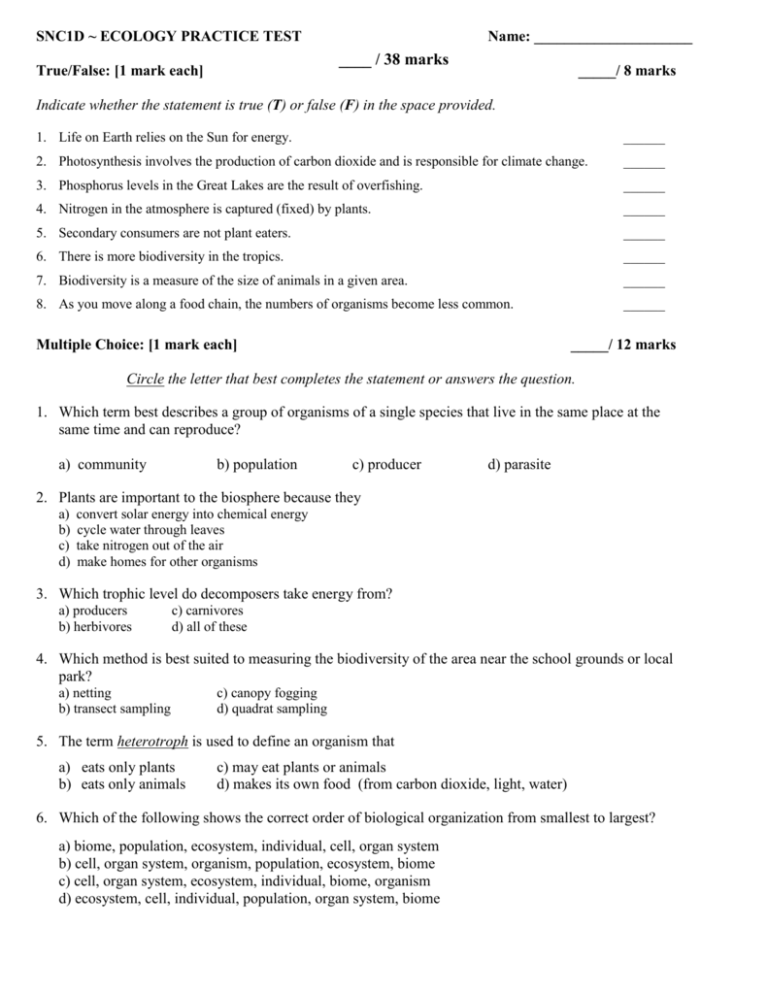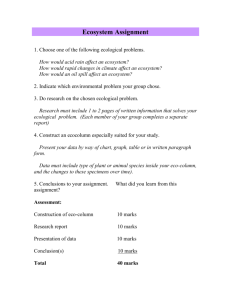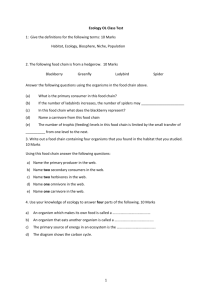Ecology Practice Test
advertisement

SNC1D ~ ECOLOGY PRACTICE TEST Name: _____________________ ____ / 38 marks True/False: [1 mark each] _____/ 8 marks Indicate whether the statement is true (T) or false (F) in the space provided. 1. Life on Earth relies on the Sun for energy. ______ 2. Photosynthesis involves the production of carbon dioxide and is responsible for climate change. ______ 3. Phosphorus levels in the Great Lakes are the result of overfishing. ______ 4. Nitrogen in the atmosphere is captured (fixed) by plants. ______ 5. Secondary consumers are not plant eaters. ______ 6. There is more biodiversity in the tropics. ______ 7. Biodiversity is a measure of the size of animals in a given area. ______ 8. As you move along a food chain, the numbers of organisms become less common. ______ Multiple Choice: [1 mark each] _____/ 12 marks Circle the letter that best completes the statement or answers the question. 1. Which term best describes a group of organisms of a single species that live in the same place at the same time and can reproduce? a) community b) population c) producer d) parasite 2. Plants are important to the biosphere because they a) b) c) d) convert solar energy into chemical energy cycle water through leaves take nitrogen out of the air make homes for other organisms 3. Which trophic level do decomposers take energy from? a) producers b) herbivores c) carnivores d) all of these 4. Which method is best suited to measuring the biodiversity of the area near the school grounds or local park? a) netting b) transect sampling c) canopy fogging d) quadrat sampling 5. The term heterotroph is used to define an organism that a) eats only plants b) eats only animals c) may eat plants or animals d) makes its own food (from carbon dioxide, light, water) 6. Which of the following shows the correct order of biological organization from smallest to largest? a) biome, population, ecosystem, individual, cell, organ system b) cell, organ system, organism, population, ecosystem, biome c) cell, organ system, ecosystem, individual, biome, organism d) ecosystem, cell, individual, population, organ system, biome 7. Using the 10 % energy budget, calculate the amount of energy that REACHES THE SNAKE if the plant contains about 4237 units of energy. plant (4237 units of energy) a) 423.7 units mouse b) 42.37 units snake c) 4.237 units owl d) 0.4237 8. Phosphorus in the soil comes from: a) weathering/erosion of rocks b) decaying organisms c) the addition of fertilizer d) all of these 9. During eutrophication the lake ecosystem changes. What happens after the algal bloom? a) Fish eat the algae and the populations explode. b) The temperature of the lake increases. c) The lake becomes more acidic. d) The algae cover the surface and plants underneath die. 10. Which trophic level has the largest biomass? a) plants c) carnivore b) herbivore d) decomposer 11. Which of the following best defines an ecosystem? a) a group of organisms that can interbreed b) smaller organisms that get eaten by larger organisms c) the feeding level of an organism in a food chain d) all of the interactions between living things and their environment 12. The pattern of continual use and reuse of nutrients that living things need is called a) biodiversity b) sustainability c) evolution d) nutrient cycle 13. The population of lynx in North America is SLOWLY on the decline despite conservation attempts by wildlife ecologist. The greatest threat faced by lynx today is the destruction of their habitat. Because lynx need large areas of undisturbed forest, logging and road building creates barriers and isolated populations. What risk category would the lynx belong to? a) extinct b) extirpated c) endangered d) threatened Matching: [1/2 mark each] _____/ 5 marks Carefully read each question and complete each blank with the appropriate capital letter. Classify each of the following as either a producer (P) or consumer (C) or neither (N) 1. a polar bear_______ 2. maple tree_______ 3. the sun_______ 4. algae_______ 5. a weasel _________ Classify each of the following as biotic (B), or abiotic (A). 6. air _________ 7. tree_______ 8. seawater_________ 9. clouds_________ 10. bacteria_________ Short Answer: [marks as shown] Answer the questions in the space provided. 1. Describe what will happen with the release of DDT into the food chain. In your description the name of the process should be included. _____/ 2 marks DDT → zooplankton→ small fish → large fish → bald eagle ____________________________________________________________________________________________ ____________________________________________________________________________________________ _____/ 2 marks 2. List any two abiotic factors that might cause a population to decrease and why. ____________________________________________________________________________________________ ____________________________________________________________________________________________ 3. Study the information in the chart below….. SPECIES SIZE HUMAN INTERACTIONS SPECIES DIET INDIVIDUAL RANGE BIOTIC POTENTIAL SPECIES RANGE Species E small few herbivore large low small _____/ 2 marks Species F small few carnivore small high large a) Which species will be the most likely to be ONLY vulnerable? Species G large many carnivore large high large Species H small many omnivore small high large __________________ b) Why?______________________________________________________________________________________ 4. Use the following pairs of terms to create a sentence that is MEANINGFUL WITHIN THE CONTEXT OF THIS ECOLOGY UNIT and uses additional scientific terminology in establishing the connection. steward/stewardship & ecosystem _____/ 2 marks _________________________________________________________________________________________ _________________________________________________________________________________________ _________________________________________________________________________________________ _________________________________________________________________________________________ mountain lion snakes rabbits shrew deer mice bear grasses, shrubs, wild berries, seeds insects _____/ 5 marks 1. Name one organism at the first trophic level. ____________________________ 2. Name an organism that is an omnivore. ____________________________ 3. Name an organisim that is a heterotroph. ____________________________ 4. Name an organism that is a secondary consumer. ____________________________ Write the members of a food chain that ends in a secondary consumer. _______________________________________________________________________________________ Application: [marks as shown] Answer the questions in the space provided. You have an exciting job during the summer break from university. You are an assistant park ranger who must determine the biodiversity of the following animals in a sector area of a three square kilometre sector. You have been observing all summer (you had to camp there) and determined the populations to be from observation and calculation: Squirrels 300 Beavers 10 Porcupines 8 Black Bear 1 Moose 2 Bald Eagles 2 Deer 4 Fox 8 Rabbits 100 Human 1 1. In your report you must calculate the relative abundance for the rabbits for this sector. ___/4 marks 2. What is the species richness of this sector? ________ ___/1 mark 3. Calculate the biodiversity index of this area for the studied species. ____/2 marks 4. Do you think that counting yourself in the study is accurate? Explain. ____/1 mark









